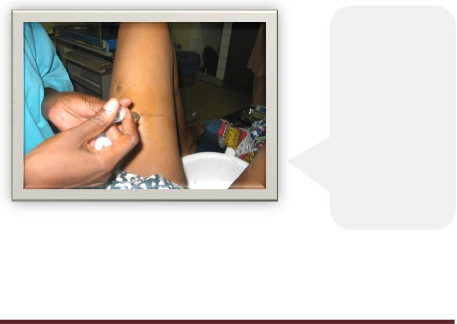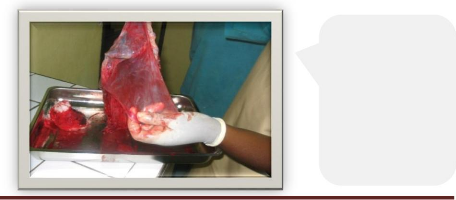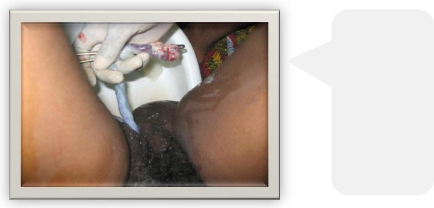B.2.2 Nursing Management of Second Stage of Labour
[31]
· Nurse provides comfort and support during the
patient's pushing effort and encourages her to push harder and not let any
breath out or to put all her effort into the push and not into making noise.
· When the patient feels an uncontrollable urge to push
(bear down), the nurse can help by encouraging her positioning.
· Most patients respond positively to touch in labour.
They appreciate deft, gentle handling by the staff. The patient's awareness of
the soothing qualities to touch changes the labour process and many patients
develop hyperesthesia during labour.
· Breathing techniques are used to increase abdominal
pressure thus assisting in expelling the foetus.
· It is important to note that tension and fear are part
of the cycle of pain and everything possible should be done to reduce it. This
includes giving information both before and during labour .
· Constant presence is vital. Words of praise, comfort,
encouragement and reassurance will vary from nurse to nurse [35].
· Mobility and positions for labour: The freedom to move
and adopt different positions is an important way of helping women to cope with
the pain of labour and may aid progress [35].
· Distraction is another means of increasing relaxation and
coping with discomfort. During early labour, light cards or other games may
serve as distraction.
· Time of birth is noted. Baby's birth weight, cranial
perimeter, brachial and thoracic perimeters, and the APGAR score are noted.
· Immediately after birth, the care given focuses on
assessing and stabilizing the newborn. As the head is being delivered,
suctioning of the baby is done. Moist gauze sponges are used to wipe the nose
and the mouth.
· Where the baby is placed should be warm, hygienic,
vitamin K is administered for hemostasis. Gentamycine eye drops given as
prophylaxis against neonatal conjunctivitis. The clamped umbilical cord is
cleaned with alcohol and covered with sterile gauze.
· Brief assessment of the baby can be performed when the
mother is holding the baby. This includes checking baby's airway.
· Baby should be dressed in the appropriate baby's wears as
fast as possible to minimize hypothermia.
· To ensure correct identification the nurse gives the
mother matching identification bands in the delivery room.
·
To enhance attachment, breastfeeding can be encouraged if the
mother and the baby desire.
· While waiting for signs of placental separation, the
nurse gently palpates the uterus to check for ballooning caused by uterine
relaxation and subsequent bleeding into the uterine cavity [22].
B.2.3. Nursing Management of Third Stage of Labour
[25]
This process is an active one due to the high risk of
haemorrhage involved. It is therefore usually referred to as Active Management
of Third Stage of Labour (AMTSL) divided into 7 well-defined stages.
1. Firstly immediately after expulsion of the baby, verify
absence of a second foetus by palpating the abdomen.
2.

Figure 3:
Active Management of third satge of labour.
A patient here is being injected intra-muscularly with 4ml of 10
I.U. Syntocinon.
Secondly, administer 10 IU of Oxytocin intramuscularly as shown
below.

Figure 5: Examination of the placenta.
This midwife is inspecting the shiny amnion making sure it is
intact.
3. Thirdly, wrap the maternal umbilical cord around the clamp and
wait for the next uterine contractions as shown below:
4.

Delivering the placenta by continuous traction on the umbilical
cord.
Figure 4:
Exercise continuous traction on the umbilical cord
45o below the horizontal to prevent detachment from the placenta,
meanwhile also continue applying a counter pressure against the uterus pushing
it upwards and 45o above the horizontal.
5. After delivery of the placenta, massage the uterus.
6. Examine the placenta, as shown below:
In examining the placenta, check both the maternal and foetal
faces. In the maternal face: - Look out for calcifications whether there are
blood clots, fibrosis etc.
- Inspect the membranes for missing portions.
- Examine the cotyledons (16-18 irregular lobes of connective
tissue separated by septa formed during placentogenesis) .
In the foetal face:
- Check if the shining amnion is intact.
- Inspect the blood vessels embedded in the chorion
- Carefully check for proper insertion of the umbilical cord.
· Finally weigh the placenta, which is usually
1/6th the weight of the foetus ( 500g). The Nurse disposes of the
placenta according to the wish of the mother. Women usually carry it home and
dispose of it according to their custom [25].
· Lacerations are repaired or episiotomies sutured. The
vulva area is gently cleansed
with warm sterile water or normal saline and
sterile pads applied to the perineum.
· The nurse should record the following information
about the delivery of the placenta. Exact time, whether it was delivered
spontaneously, which side of the placenta presents.
· Examination of cervix, perineum cleaned, woman's gown
changed and woman placed comfortably to rest.
· Following the delivery, the woman might feel chilled and
shake uncontrollably. She should be covered with a warm blanket to provide
warmth.
· Nurse should note reaction of the mother and help her to
adjust.
| 


